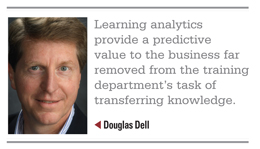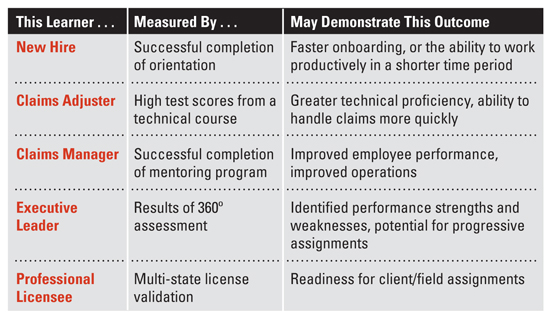We're never that curious about how well our car is operatinguntil the check engine light goes on. But had we been a little moreinquisitive, maybe even proactive, we could have noticed we wererunning low on oil, observed a frayed fan belt, or added a bit ofair to a tire—all before the warning lightflashed. 
That same curiosity should apply to monitoring learning in yourorganization. Data logs from your intranet, learning managementsystem, and social media—even brief classroom surveys—hold manysecrets about your learners. You can determine what trainingthey prefer, whether existing demand is being served, and theextent of their capacity for learning consumption.
|In addition, while analytics are important to making certainthat training is developing people and improving corporateperformance, they also can provide perspective about how yourorganization's learning programs perform within the industry.
|The Promise
Learning analytics is theexamination of learner-produced data to discover how employeesengage with training and, ultimately, what outcomes it produces.After any training experience—classroom, online or via knowledgedatabases or performance support tools—data is generated thatrepresents what happened during the activity: A learner completed acourse; scored an 87 on a test; clicked six times on the same linkand left the website; or posted a comment on an expert forum. Allof these captured metrics represent learning analytics.
Depending on the size and budget of your training organization,data might be represented in a sophisticated dashboard that is usedto drive program change. Analytics also might be used in lesssophisticated but still telling ways, such as monitoring studentvolumes and program satisfaction and managing continuing educationlicensing or other compliance requirements. The point is, data canidentify challenges and opportunities and inspire change in thelearning organization and beyond.
|Aligning Analytics by Audience
One sizedoes not fit all, nor does one metric mean the same thing to alllearners. Rather, analytics and results need to be aligned with thelearner and the training. The following table segments commonlearner types and training within an organization; gives an exampleof an appropriate metric; and suggests a predictive outcome—apotential result that can be inferred from the data. 
To illustrate this point, one can look to the new insuranceindustry Property Technical Certification (PTC). After adjusterscomplete the 12-course PTC I program, their average improvementover pre-test scores has been quite significant, in general. Onelikely interpretation is that this data indicates that the programprovides a thorough instructional design, allowing learners toabsorb and retain the curriculum. Perhaps more interestingly,Crawford reports that initial data among certificate holders alsoshows improvement in the speed of claims handling and a reductionin the days that claims remain open. In this way, learninganalytics provide a predictive value to the business far removedfrom the training department's task of transferring knowledge.
|When considering the variety of data trainers work with eachday, you can see the power of information and its potential impacton the organization. This highlights the importance of learninganalytics and the value a learning organization can deliver to thebusiness by correlating and managing this data. In addition,linking test results to actual improvements in job performancevalidates training and helps organizations develop the ROI analysesnecessary to support their educational budgets, which is always akey concern among training managers.
|How Are We Doing?
Data analysis canindicate whether and how training contributes to the performance ofan organization. By understanding the high and low ranges for eachpiece of data, an organization can determine whether it isoperating within acceptable limits. However, with learninganalytics, a company is often challenged by a lack of parametersthat help interpret how its results map to those in the rest of theindustry. By knowing industry standards, however, an insurer canunderstand its performance within a larger context. That is wherebenchmarking comes into play.
Benchmarking within the insurance or any other industry is notalways simple, particularly in highly competitive or regulatedenvironments. This is where industry associations play an importantrole as clearinghouses for data by protecting individual inputs topresent the collective view. Associations can harness analyticwisdom, provide a perspective on best practices, and oftenrecommend vendors to help an organization move in a newdirection.
|
If you are not interested in sharing data, then using a researchcompany specializing in learning analytics is an option. Such firmscan conduct primary research, comb through secondary research, andconduct qualitative research by interviewing business contacts orconducting focus groups to identify industry standards and bestpractices. They can also develop reports, dashboards, and analyticdatasets out of your raw data. Either approach will yield anexternal perspective on internal performance. Benchmarking willalso provide access to networking opportunities and potentialcollaborative partnerships.
|Key Recommendations
Now that we havediscussed learning analytics and the importance of benchmarking, itis time to put this knowledge to work. Following are a few broadrecommendations for learning organizations and trainingdepartments, as well as for those operating a learning managementsystem (an online system for learning that can include courses,knowledge databases and forums, collaboration, and othercomputer-supported learning tools).
Best Practices for Analytics: LearningOrganization
- Whatever you choose to measure, make sure it is available on acontinuous basis. A snapshot only gives you information about apoint in time, while a trend provides direction.
- Keep the power of benchmarking in mind. Make sure a metric isconsistent with how others measure for the benefit of comparisonwith peers and the industry.
- Make sure what you measure is meaningful and, when analyzed,provides value to the organization. Meaningful analytics correlateto business impact.
- Optimize existing systems and processes to gather analytics.Technology must be your partner in gathering, assessing, andmanaging learning analytics.
- Realize that trended analytics will result in change. Managethe change process with the goal of improving the learningfunction.
Best Practices for Analytics: LearningManagement System
- Know where your learners access online training—intranet,learning management system, the Internet, and so on—and ensure thatmultiple points of entry are available where your audience browses.You can then track page accesses and dwell times to ascertainwhether learners are interacting with the intended training.
- Treat the system like a website and track activity on top-levelpages, click streams, and drop-offs. Don't let the system driveaway learners.
- Index the top courses selected and consider additional contentin high-demand subject areas. In addition, monitor key search termsto determine whether unmet content needs exist.
- If your organization uses social media for collaborativelearning, incorporate basic measures within your learninganalytics. Informal learning will become the majority of yourlearning in the future. Don't wait to start measuring it.
Putting this information into action starts with assemblingdata, understanding the audience it represents, and correlating itto your organization's performance requirements. By tying theseconcepts together, a learning organization can offer importantinsights about what the business must do to train employees forbetter performance, ultimately bringing far greater value to theenterprise than data alone can provide.
Want to continue reading?
Become a Free PropertyCasualty360 Digital Reader
Your access to unlimited PropertyCasualty360 content isn’t changing.
Once you are an ALM digital member, you’ll receive:
- All PropertyCasualty360.com news coverage, best practices, and in-depth analysis.
- Educational webcasts, resources from industry leaders, and informative newsletters.
- Other award-winning websites including BenefitsPRO.com and ThinkAdvisor.com.
Already have an account? Sign In
© 2024 ALM Global, LLC, All Rights Reserved. Request academic re-use from www.copyright.com. All other uses, submit a request to [email protected]. For more information visit Asset & Logo Licensing.








